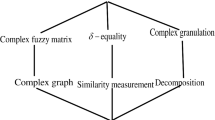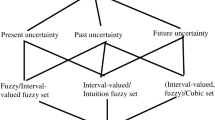Abstract
The precise measurement of uncertainty and its fluctuation in the vague attributes is considered as one of the most crucial task by the data analytics researchers. To accomplish this tasks, the calculus of complex vague concept lattice is introduced recently for adequate analysis of vagueness and its graphical visualization. In this process, a problem is addressed while dealing with similar vague attributes exists in the given complex fuzzy contexts. To conquer this problem, a method is proposed for acquisition and transformation of complex vague contexts using the properties of Cartesian product and granular computing with an illustrative example.





Similar content being viewed by others
References
Alcalde C, Burusco A, Fuentes-Gonzalez R (2012) Composition of \(L\)-fuzzy contexts. In: Proceedings of 10th International Conference on Formal Concept Analysis 2012, pp 1–14
Ali M, Smarandache F (2017) Complex neutrosophic set. Neural Comput Appl 28(7):1817–1834
Burusco A, Fuentes-Gonzalez R (1994) The study of the L-fuzzy concept lattice. Matheware Soft Comput 1(3):209–218
Burusco A, Fuentes-Gonzales R (2001) The study on interval-valued contexts. Fuzzy Sets Syst 121(3):439–452
Bustince H, Burillo P (1996) Vague sets are intuitionistic fuzzy sets. Fuzzy Sets Syst 79(3):403–405
Chen SM (1995) Measures of similarity between vague sets. Fuzzy Sets Syst 74:217–223
Chen SM, Lee SH, Lee CH (2010) A new method for generating fuzzy rules from numerical data for handling classification problems. Appl Artif Intell 15(7):645–664
Chen SM (2011) Fuzzy forecasting based on high-order fuzzy logical relationships and automatic clustering techniques. Expert Syst Appl 38(12):15425–15437
Chen SM, Chang CH (2015) A novel similarity measure between Atanassov’s intuitionistic fuzzy sets based on transformation techniques with applications to pattern recognition. Inf Sci 291:96–114
Chen SM, Chang CH (2016) Fuzzy multiattribute decision making based on transformation techniques of intuitionistic fuzzy values and intuitionistic fuzzy geometric averaging operators. Inf Sci 352(C):133–149
Chen SM, Cheng SH, Chiou CH (2016a) Fuzzy multiattribute group decision making based on intuitionistic fuzzy sets and evidential reasoning methodology. Inf Fusion 27:215–227
Chen SM, Cheng SH, Lan TS (2016b) Multicriteria decision making based on the TOPSIS method and similarity measures between intuitionistic fuzzy values. Inf Sci 367:279–295
Chen SM, Cheng SH, Lan TS (2016c) A novel similarity measure between intuitionistic fuzzy sets based on the centroid points of transformed fuzzy numbers with applications to pattern recognition. Inf Sci 343:15–40
Dick S (2005) Toward complex fuzzy logic. IEEE Trans Fuzzy Syst 13(3):405–414
Dubois D, Prade H (2015) Formal concept analysis from the standpoint of possibility theory. In: Proceedings of ICFCA 2015, LNAI 9113, pp 21–38
Dubois D, Prade H (2016) Bridging gaps between several forms of granular computing. Granul Comput 1(2):115–126
Gajdos P, Snasel V (2014) A new FCA algorithm enabling analyzing of complex and dynamic data sets. Soft Comput 18(4):683–694
Ganter B, Wille R (1999) Formal concept analysis: mathematical foundation. Springer, Berlin
Gau WL, Buehrer DJ (1993) Vague sets. IEEE Trans Syst Man Cybern 23(2):610–614
Lindig C (2000) Fast concept analysis. In: Ganter B, Mineau GW (eds) ICCS 2000. LNCS, vol 1867. Springer, Heidelberg, pp 152–161
Liu P, Chen SM (2017) Group decision making based on Heronian aggregation operators of intuitionistic fuzzy numbers. IEEE Trans Cybern 47(9):2514–2530
Pandey LK, Ojha KK, Singh PK, Singh CS, Dwivedi S, Bergey EA (2016) Diatoms image database of India (DIDI): a research tool. Environ Technol Innovat 5:148–160
Singh PK, Gani Abdullah (2015) Fuzzy concept lattice reduction using Shannon entropy and Huffman coding. J Appl Non-Classic logic 25(2):101–119
Singh PK, Kumar Ch Aswani (2016) Analysis of composed fuzzy contexts using projection. Int J Data Anal Tech Strateg 8(3):206–219
Singh PK (2016) Processing linked formal fuzzy contexts using non–commutative composition. Inst Integr Omics Appl Biotechnol (IIOAB) J 7(5):21–32
Singh PK (2017a) Three-way fuzzy concept lattice representation using neutrosophic set. Int J Mach Learn Cybern 8(1):69–79
Singh PK (2017b) Complex vague set based concept lattice. Chaos, Solitons Fract 96:145–153
Singh PK, Kumar Ch Aswani (2017c) Concept lattice reduction using different subset of attributes as information granules. Granular Comput 2(3):159–173
Singh PK (2018a) Complex neutrosophic concept lattice and its applications to Air quality analysis. Chaos, Solitons & Fract 109:206–213
Singh PK (2018b) Similar vague concepts selection using their Euclidean distance at different granulation. Cognit Comput 10(2):228–241
Singh PK (2018c) Concept learning using vague concept lattice. Neural Process Lett 48(1):31–52
Singh PK (2018d) Complex fuzzy concept lattice. Neural Processing Letters. https://doi.org/10.1007/s11063-018-9884-7
Singh PK (2018e) Concept lattice visualization of data with m-polar fuzzy attribute. Granul Comput 3(2):123–137
Ramakrishna N (2009) Vague graphs. Int J Comput Cognit 7:51–58
Ramot D, Friedman M, Langholz G, Kandel A (2003) Complex fuzzy logic. IEEE Trans Fuzzy Syst 11(4):450–461
Ramot D, Milo R, Friedman M, Kandel A (2005) Complex fuzzy sets. IEEE Trans Fuzzy Syst 10(2):171–186
Selvachandrana G, Maji PK, Abed IE, Salleh AR (2016a) Relations between complex vague soft sets. Appl Soft Comput 47:438–448
Selvachandran G, Maji PK, Abed IE, Salleh AR (2016b) Complex vague soft sets and its distance measures. J Intell Fuzzy Syst 31:55–68
Selvachandran G, Singh PK (2017) Interval-valued complex fuzzy soft set and its application. Int J Uncertain Quantif 8(2):101–117
Skowron A, Jankowski A, Dutta S (2016) Interactive granular computing. Granul Comput 1(2):95–113
Ward M, Dilworth RP (1939) Residuated lattices. Trans Am Math Soc 45:335–354
Wang HY, Chen SM (2008) Evaluating students answerscripts using fuzzy numbers associated with degrees of confidence. IEEE Trans Fuzzy Fuzzy Syst 16(2):403–415
Wille R (1982) Restructuring lattice theory: an approach based on hierarchies of concepts. In: Rival I (eds) Ordered sets, NATO advanced study institutes series 83, pp 445–470
Yao Y (2016) A triarchic theory of granular computing. Granul Comput 1(2):145–157
Zadeh (1965) Fuzzy sets. Inf Control 8(3):338–353
Yazdanbakhsh O, Dick S (2018) A systematic review of complex fuzzy sets and logic. Fuzzy Sets Syst 338(2018):1–20
Zhang G, Dillon TS, Cai KY, Ma J, Lu J (2009) Operation properties and \(\delta\)-equalities of complex fuzzy sets. Int J Approx Reason 50(2009):1227–1249
Acknowledgements
Authors sincerely thank the anonymous reviewers as well as editorial team for their valuable time and comments to improve the quality of this manuscript.
Author information
Authors and Affiliations
Corresponding author
Additional information
Publisher’s Note
Springer Nature remains neutral with regard to jurisdictional claims in published maps and institutional affiliations.
Rights and permissions
About this article
Cite this article
Singh, P.K. Complex vague contexts analysis using Cartesian product and granulation. Granul. Comput. 5, 37–53 (2020). https://doi.org/10.1007/s41066-018-0136-z
Received:
Accepted:
Published:
Issue Date:
DOI: https://doi.org/10.1007/s41066-018-0136-z




